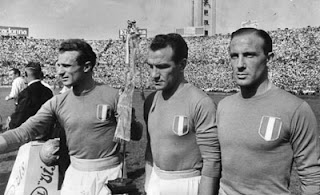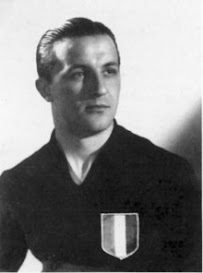Brilliant defender who died in Superga tragedy
 |
| Aldo Ballarin became one of Italy's finest defenders |
Ballarin, whose brother, Dino, also died in the accident, played at right-back in the Torino team, making more than 150 appearances and winning the scudetto - the Serie A championship title - four seasons in a row between 1945 and 1949.
A defender who was renowned for his tackling and heading ability but who also used the skills he had learned as a winger in his youth to be an effective attacker, Ballarin won nine international caps in the azzurri of Italy.
He remains the only player born in Chioggia to play for the Italian national team.
One of six children in his family, Aldo would play football for hours in the street near his home as he was growing up. Of his three brothers, two would also play professionally. Dino, who was a little under two years younger than Aldo, was on Torino’s books as a goalkeeper.
At the age of 13, Aldo began playing for the youth team of Clodia, a local amateur club, before signing apprentice professional terms with Rovigo, a Serie C club about 55km (34 miles) from Chioggia. He then moved much further away to play for Triestina, based in the north-eastern city of Trieste in the Friuli-Venezia Giulia region.
 |
| Ballarin (right), with Torino teammates Valentino Mazzola and Ezio Loik, line up for Italy |
By then, he was attracting the attention of many of Italy’s top clubs and his return to Serie A action with Triestina regularly drew talent scouts to his games. It was ambitious Torino, who had been crowned Serie A champions in the final season before the suspension, who wanted him most.
Under the presidency of Ferrucio Novo, the former player whose status in the city enabled him to attract much financial support, Torino were able to find 1.5 million lire to secure Ballarin’s transfer in 1945.
It was more than they had paid for Valentino Mazzola, the attacking midfield player who was their captain and who was regarded as one of the best players in Italy. Italian football had never seen so much money change hands for a right back.
But it proved to be money well spent as Ballarin became one of Italy’s most accomplished defenders. Had it not been for the tragedy of 1949, when the plane carrying the Torino team back from a friendly match against Lisbon in Portugal, crashed on its approach to the city’s airport in heavy, low cloud, he would doubtless have won many more international caps.
 |
| Aldo's brother Dino, who played in goal, also died in the crash |
When the basilica became visible in the murk, it was too late to take evasive action. The plane did not hit the main structure of the church, built by Filippo Juvarra in the early part of the 18th century, but collided with a retaining wall on an embankment at the rear of the building. Only the tail of the aircraft remained intact.
All 31 people on board died, including 18 players, as well as the team’s English coach, Leslie Lievesley, and four other officials, plus three journalists. Aldo Ballarin’s brother, Dino, who had yet to make his senior debut, was on the flight only because Aldo had convinced the management to take him to Lisbon as a reward for his hard work in training.
The crash not only robbed Serie A of the team that had become known as Il Grande Torino - the Great Turin - but the core of the Italy national team. Of the Torino first team, the only survivor was the left-back, Sauro Tomà, who missed the trip to Lisbon through injury. President Ferruccio Novo stayed at home because of influenza.
The Ballarin brothers were mourned as much in Chioggia as well as Turin. As a mark of respect, the town’s municipal stadium was renamed Stadio Aldo e Dino Ballarin.
Union Clodiense, the team that plays there, still wear the maroon shirts favoured by Torino, that were adopted by one of its predecessors, Union Clodia Sottomarina, in 1971.
.jpg) |
| The Stadio Aldo e Dino Ballarin from the air. The main part of Chioggia is in the background |
Chioggia, where the Ballarin brothers were born, is an historic fishing port at the southern limit of the Venetian lagoon. It is accessible by boat direct from Venice, although the service runs each way only once a day. The most popular route is via ferry and bus along the length of the Lido island. Chioggia itself is actually a small island, linked by a causeway to the resort of Sottomarina. Like Venice, Chioggia has a number of canals but, unlike Venice, it is not closed to cars. The main street, Corso del Popolo, has a number of churches and some fine fish restaurants. The Stadio Aldo e Dino Ballarin, which houses about 3,000 spectators, can be found on Via della Stazione.
 |
| Filippo Juvarra's magnificent Basilica di Superga stands on a hill overlooking the city of Turin |
The Superga tragedy is commemorated with a simple memorial at the site of the crash, at the back of the magnificent 18th century Basilica di Superga. Mounted on a wall, the damaged parts of which were never restored, is a large picture of the Grande Torino team, with a memorial stone that lists all the names of the 31 victims of the disaster, under the heading I Campioni d’Italia. Built between 1717 and 1731 for Victor Amadeus II of Savoy, the future king of Sardinia, the basilica fulfilled a pledge he had made to mark his victory over the French in the Battle of Turin, during the War of the Spanish Succession. The basilica’s elevated position means that it often sits serenely in sunlight while mist shrouds the city below. It can be reached by a steep railway line, the journey taking about 20 minutes.
Also on this day:
49BC: Caesar crosses the Rubicon
987: The death of former Doge of Venice San Pietro Orseolo
1834: The birth in Naples of historian and politician Lord Acton
1890: The birth of silent movie star Pina Menichelli
1903: The birth of sculptor and car designer Flaminio Bertoni
1959: The birth of football manager Maurizio Sarri
2009: The death of publisher Giorgio Mondadori





